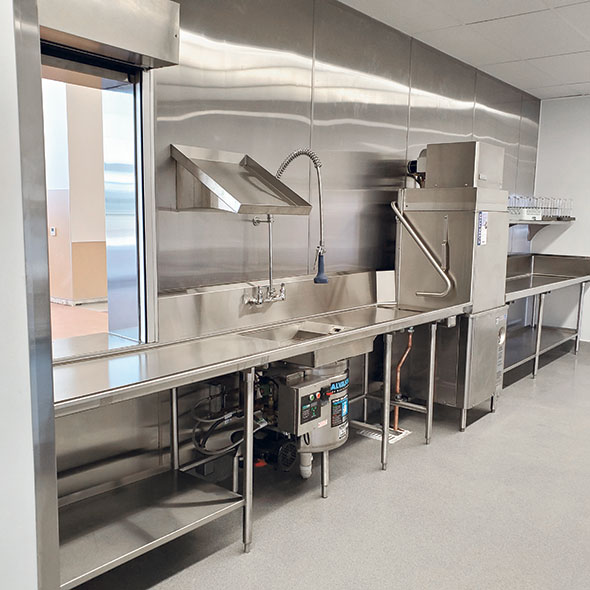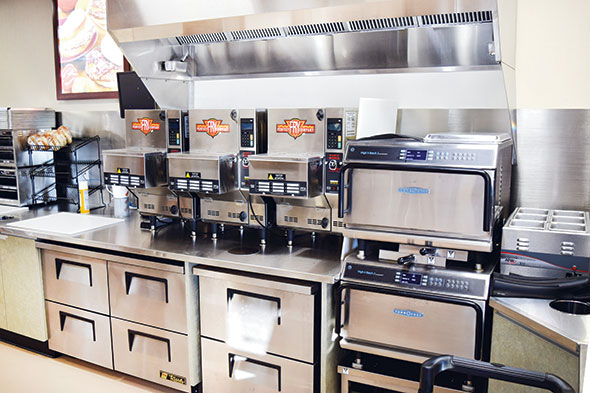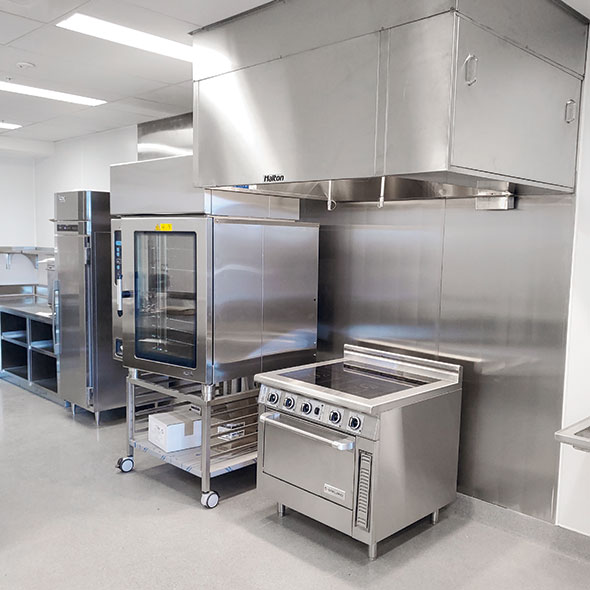Ventless represents an emerging foodservice equipment segment. And like every other type of equipment, whether ventless is right for a specific application comes down to a variety of factors, including menu composition, service style, infrastructure and more.
 By specifying a ventless dishwasher at this Colorado school, Webb Foodservice Design was able to help manage project costs without compromising sanitation.
By specifying a ventless dishwasher at this Colorado school, Webb Foodservice Design was able to help manage project costs without compromising sanitation.
Foodservice operator segments that seem to naturally gravitate to this technology include convenience stores and quick-service restaurants, according to Tilghman Grandstaff, director of operations for Clark Retail Solutions, Lancaster, Pa. Two forms of ventless equipment these segments seem to use on a regular basis are rapid-cook ovens and fryers. “Many of our customers use this type of equipment not because it’s ventless but because it is good for their menu applications,” Grandstaff says. “The product that comes out of these units — you can run an entire fine-dining operation with them and the customer would never know.”
Specifically, c-stores and QSRs like the fact that this equipment can help meet customer expectations for speed of service, Grandstaff says. Customers usually expect their food in five minutes or less when making a purchase from these operators. In fact, one c-store Grandstaff works with uses four ventless fryers and two to four ventless double-stacked rapid-cook ovens, depending on the location, to help execute its menu. “It helps them with the speed of the cooking process,” he says. “Plus, these units are pretty easy to train the staff on, given that the equipment’s menus are either icon- or word-driven.”
 To execute its menu in a timely manner, Rutter’s c-stores rely on a battery of ventless equipment that includes fryers and high-speed ovens.
To execute its menu in a timely manner, Rutter’s c-stores rely on a battery of ventless equipment that includes fryers and high-speed ovens.
Of course, ventless cooking equipment is not the exclusive domain of c-stores and QSRs. A recently completed elementary school foodservice project in Littleton, Colo., included a variety of ventless items, including a rapid-cook oven, a combi oven and a dishmachine, according to Ray Soucie, senior project manager for California-based Webb Foodservice Design, the project’s foodservice designer. Located on a Native American reservation, the operators use the equipment not only to feed students during the school day but also to support various tribal rituals and ceremonies that involve food. In this instance, it’s important to note that the entire kitchen is not completely ventless because it includes a six-burner induction range, which, by local code, requires a hood.
“By using certain ventless items, I was able to reduce the size of the hood from 12 feet down to 4 feet on the cookline,” Soucie notes. “And we completely eliminated the need for a vapor hood over the dishmachine. They were trying to value-engineer the building and we saved them somewhere between $40,000 to $50,000 on the hoods. They love the advanced cooking technology. And they were able to apply for some energy credits from the county because they are using ventless and induction cooking.”
Specifying Ventless
Another key benefit of working with ventless equipment is that it allows foodservice operators to set up shop or place equipment in areas that might otherwise be off-limits to them for a variety of reasons. For example, by using ventless equipment, a foodservice operator might be able to put a coffee shop or a quick-service concept on the third or fourth floor of a building. “Putting in a ventless high-speed oven, we are able to offer food without having to build out ductwork,” Soucie says. In these instances, though, it’s important to construct a menu that works well with the ventless equipment the operation will use.
Soucie is in the early stages of another project, which will place the kitchen in the lower levels of the building, and ventless equipment is emerging as a compelling option. “We could reduce the amount of exhaust if we use ventless in three out of the four spaces. And that’s a big thing for architects — they like to use ventless equipment in multiuse and high-rise spaces. That allows us to put foodservice into places we might not otherwise be able to go.”
 For a Colorado school foodservice project, Webb Foodservice Design specified a ventless combi oven that the culinary staff uses to feed students and support cultural events. Local code requires the kitchen’s induction range to reside beneath a Type 1 hood, though.
For a Colorado school foodservice project, Webb Foodservice Design specified a ventless combi oven that the culinary staff uses to feed students and support cultural events. Local code requires the kitchen’s induction range to reside beneath a Type 1 hood, though.
Ventless dishwashers can also offer more flexibility when trying to determine where to place this equipment. “You can definitely place a ventless dishwasher in different areas without having to worry about affecting the ductwork or any other lines running through the back of the house,” Grandstaff says. “You can basically place it anywhere. There’s no decline in productivity or anything like that. You may notice a little more heat and moisture in that back room, however. For that reason, we suggest placing them away from other equipment that might be affected by heat or moisture. But that issue does not trump the benefits this equipment can offer.”
Some ventless warewashers have features that can help mitigate extra moisture and heat, making these units an intriguing option for foodservice designers. “The single-rack machines work as well as or better than some ventilation systems I have seen,” says Chris Wair, design principal, Reitano Design Group, Indianapolis. “The interlock is an option for these units and they do a good job of knocking down that steam before the user opens the door.”
Operators may become interested in ventless equipment when they want to bring more of the action out front, where customers can watch their pizzas roll through a ventless conveyor oven or someone cook a stir-fry item to order on a ventless plancha. Colleges represent one example of this. “The people attending college today have all grown up watching the Food Network and know the celebrity chefs. So, they want to see that up front,” says Ted Doyals, principal, Ricca Design Studios, headquartered in Greenwood Village, Colo. “The more ventless there is, the more flexibility it gives us in our design process. It allows us to put equipment in places where we might not have thought possible at the start of the project.”
Ventless planchas represent one type of equipment that can help in these instances. “We try to use those as multiuse spaces,” Doyals says. “Maybe they cook during service and become a demo kitchen after hours. That can help justify the cost. The more we can bring out front so the customers can see it — we like that as a design process, provided it fits into the applications.”
Purchasing Considerations
While ventless technology offers some promise for operators, this technology also has tradeoffs. “We’d be going from gas cooking equipment to electric. That means our electric service will have to be upsized,” Doyals notes. “So, we have to decide which way is better.” Also, some operators may not want to cook with electric equipment, he adds. “That leads to a conversation with the owner-operator because some chefs don’t like to cook with electric. They may prefer live fuel, let’s say. So, they may need to adjust the menu.”
Like any other equipment, when specifying ventless items, operators should develop an understanding of what goes into maintaining these units. “They have to be kept clean. You can’t let these things go for weeks at a time,” Wair cautions. “You have to do the daily cleaning. They have air filters, and you have to clean them on a daily basis, or you will have an issue. In the case of the filters on a ventless combi oven, these units are going to shut down on you if you don’t clean them regularly.”
With ventless fryers, for example, operators will still need to regularly filter the oil. And operators will need to change the equipment’s filters — how often will depend on volume, menu composition and other factors.
“There’s probably more upkeep with a ventless unit because you’re trying to filter that grease and heat in it because you are not venting it out through the building,” Grandstaff says. “But for applications such as c-stores, the food quality, speed and ease of use make them worth it.”
And just because a piece of equipment is ventless, that does not necessarily mean the operator will be able to use it without a vent. “The issue we are running into now is that a lot of townships where we put ventless cooking equipment are requiring us to put in a hood,” Grandstaff says. “In some cases, we’ve been able to put a Type 1 hood, which is helpful.”
Today’s ventless technology offers plenty of potential when it is properly understood and applied in the right set of circumstances. The value is in the eye of the operator.



